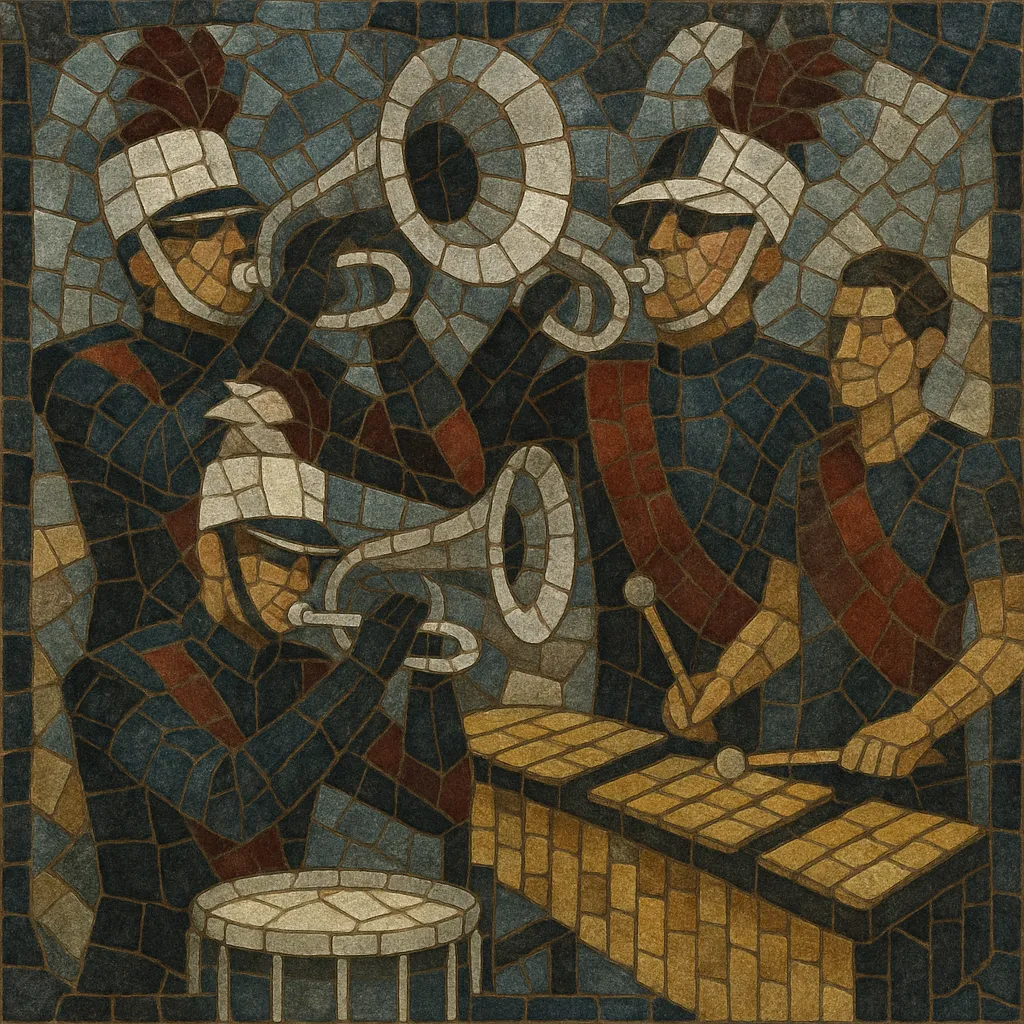
Drum and bugle corps is a marching music idiom built around a battery of marching percussion, a powerful brass choir, and a stationary or semi‑stationary front ensemble ("pit") of mallet and auxiliary percussion. It is performed on football fields and parade routes, blending musical precision with synchronized visual design by a color guard.
Historically rooted in military signaling units, the genre evolved into a competitive performing art with intricate arrangements, demanding drill, and theatrical production values. Modern corps programs are typically 10–12 minutes long, through‑composed, and draw repertoire from classical, jazz, film, and contemporary concert music, adapted for mobile, high‑impact performance.
Drum and bugle corps emerged in the United States from post–World War I veterans’ organizations and civic groups that maintained military‑style drum and bugle traditions for parades and ceremonies. American Legion and VFW sponsorship helped standardize contests and encouraged musical development beyond simple field signals. Instrumentation centered on valveless or single/limited‑valve G bugles and marching drums executing codified rudiments.
By the 1960s, junior and all‑age circuits expanded, and independent show designers began crafting longer, more musical programs. In the early 1970s, leading corps formed new governance to promote performer‑focused rules and touring schedules, catalyzing a shift from parade exhibition to purpose‑built field productions. This era established the modern competitive model with judged captions for music, visual, and general effect.
Arranging became more symphonic and jazz‑inflected, battery books introduced complex hybrid rudiments, and multi‑tenor and multi‑bass writing matured into the characteristic split‑voice style. Front ensembles grew with concert percussion, timpani, and mallet keyboards, increasing harmonic color. Rule changes gradually permitted any‑key brass, amplification for the pit, and carefully regulated electronics, enabling greater dynamic range and timbral variety while retaining the idiom’s acoustic core.
The model spread internationally with circuits in Europe and Asia adopting similar adjudication and design philosophies. Contemporary productions feature coordinated musical/visual narratives, fast drill, layered polyrhythms, and cinematic pacing. While remaining largely instrumental, the genre now integrates multidisciplinary staging and nuanced sound design, preserving its brass‑and‑battery identity within a theatrical framework.
Write for a brass choir (trumpets/mellophones/baritones–euphoniums/tubas) as the primary harmonic and melodic voice; a marching battery (snares, multi‑tenors, split bass line, occasionally cymbal line) for groove and momentum; and a front ensemble (marimbas, vibraphones, auxiliary percussion, timpani, and tasteful electronics) for color and sustain. Coordinate with a color guard for visual emphasis and thematic storytelling.
Design a 10–12 minute continuous production with an opening impact, development, lyrical/pacing relief, percussion feature, build to a climax, and a final “hit.” Use seamless transitions, recurring motifs, and clearly staged moments that align musical arrivals with visual forms and equipment work.
Favor clear voice‑leading in 4–6 part textures, powerful unisons/octaves for arrivals, and antiphonal call‑and‑response between sections. Balance fanfare articulation (marcato, accent/tap figures) with sustained chorales. Write playable ranges with staged endurance, and score tutti chords to amplify upper partials outdoors. Dynamic shaping and breath planning are essential.
Craft snare/tenor books with hybrid rudiments, metric modulation, and interlocking figures. Write the bass line in split voices to outline harmony and drive impact (unison for hits, hocketing for motion). Align check patterns with the brass rhythm grid, and stage moments for clarity at distance. Prioritize clarity of hands and timing over density.
Layer mallet ostinati, counterlines, and harmonic pads to glue brass and battery. Use timpani for pedal points and harmonic pivots. Employ amplification and electronics sparingly to reinforce timbre and sustain without masking acoustic clarity. Orchestrate attacks to match battery stick heights and brass articulations for unified impacts.
Stage musical voices to project (brass arcs for chorales, compressed forms for hits, spread forms for stereo effects). Rehearse with a metronome and sub‑divisions, integrate visual tempi with musical phrasing, and build tempo step‑ups gradually. Clean ensemble timing, balance, and releases obsessively—clarity wins outdoors.

